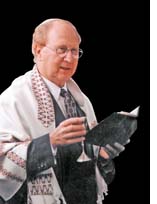Click here to hear Cantor Merel’s chanting of Kol Nidre
By Cantor Sheldon Merel

SAN DIEGO — On the evening of Yom Kippur (Day of Atonement), the holiest day of the Jewish year, Jews around the world gather in their synagogues to hear the chanting of Kol Nidre (all vows) The ark is opened at the beginning of the service , and white clad Torah scrolls (five books of Moses) are removed. They are held by the rabbi and two officers of the congregation as they face the standing congregation. The cantor and choir then chant the stirring music of the Kol Nidre. As the final echoes of the music finish reverberating in the sanctuary , the Torahs are returned to the Ark, and the evening worship service begins. The majestic singing of the music has become more important than its text, and so popular that that the Yom Kippur evening is called Kol Nidre.
The chanting of Kol Nidre , although a musical climax, precedes the beginning of the service, and isn’t actually a prayer. It’s origin is traced back to an eighth-century dry legal formula from a Talmudic tractate, (Nedarim) written in Aramaic (like the Kaddish), and does not even address God. The 8th century formula was created for those wishing to annul only personal vows broken to God, The ritual had to be recited three times before a Jewish court of “three” learned men of the community. Note the repetition of the number “three” : three men in the Bet Din, (court), and the text is chanted three times. Many years later it was adopted into the Yom Kippur evening service, and chanted as a prelude to the beginning of the evening worship service. In Reform congregations Kol Nidre is sung once, often preceded with a beautiful cello version.
During the Spanish Inquisition in the 15th century, Jews were forced to convert to Christianity in order to survive, and could only practice Judaism secretly. The Kol Nidre text could be recited to absolve them of those vows, and allow them to participate in the evening prayers. In modern times, the three people holding Torahs at the beginning of the service symbolically represent the ancient Jewish court.
The text and music of the Kol Nidre differs between Ashkenazic and Sephardic (European and Spanish) traditions . The Ashkenazic and Reform Kol Nidre text asks forgiveness for broken promises between this Yom Kippur and next year. Sephardic congregations ask annulment of broken promises between last Yom Kippur and the present.
According to musicologists, the first evidence of music written for the Kol Nidre text goes back to the 15th century. Through the centuries various composers added music mainly borrowed from: synagogue chants, biblical cantillations and even German troubadour songs. Cantors carried these melodies throughout northern Europe until it was finalized.
The Ashkenazic musical setting for the Kol Nidre is dramatic and elaborate. Sephardic musical versions are based on fairly simple chants from Babylonia (Iraqis) , and Spanish-Portuguese synagogue traditions.
It is important to note that the Mishnah (Talmud) clearly teaches: “If you have offended another person, forgiveness must be sought directly from the person so wronged.” Based on these words, we have a wonderful custom to ask family and friends before the Holy Days for forgiveness if we had offended them in any way.
Several years ago, I had the privilege of meeting the well known actress, Tovah Feldshuh after her one-woman show impersonating Golda Meir at the Old Globe. I asked how she finds the strength to repeat eight shows a week. Knowing I was a cantor , she said, “Its almost as tough as singing a double Kol Nidre service!” Indeed, to sing the 7 minute Kol Nidre, usually for two services, plus singing an entire service twice is also demanding.
Now you know the background and history of the Kol Nidre: its ancient text, ritual, music, and why its sung three times in traditional congregations before the start of the Yom Kippur evening service. I hope this information will heighten your appreciation of the Holy Days.
Here is the translation of Kol Nidre: “All vows we are likely to make, all oaths and pledges we are likely to take between this Yom Kippur and the next Yom Kippur, we publicly renounce. Let them all be relinquished and abandoned, null and void, neither firm nor established. Let our vows, pledges and oaths be considered neither vows nor pledges nor oaths.”
Jews the world over will observe Kol Nidre services on Tuesday, September 18.
Shana Tovah, Happy New Year.
*
Sheldon Merel is cantor emeritus of Congregation Beth Israel in San Diego